Four Day Work Week Statistics 2024 By Benefits, Sacrifices and Demographics

Page Contents
- Introduction
- Editor’s Choice
- Facts About Four Day Work Week
- General Four Day Work Week Statistics
- By Benefits
- By Sacrifices
- By Demographics
- By Preferred Number Of Days To Work In The Office By CEOs
- By Countries
- The Future Of Four-Day Workweeks
- By Steps For Companies Needed To Taken To Foster Employees
- By Demands
- By Typical Work Week Of Employees By Choice
- Recent Developments
- Conclusion
Introduction
Four Day Work Week Statistics: Work-life balance, remote work, and hybrid work are some recent terms related to office culture. Remote work was introduced during the COVID-19 period, and since then many other countries have adopted various new work cultures to try and retain employees. Four Day Work Week is a recently developed, proposed, and introduced term by many countries.
Some companies have already implemented long weekends with only 4 days to work. However, in the majority of countries, it is currently on trial by non-government and government-approved processes. These Four Day Work Week Statistics will guide you on the status of likeness of adoption of this work culture in different countries in 2024.
Editor’s Choice
- Around 54% of workers are willing to work for longer hours 4 days a week to get a longer weekend.
- 71% of companies said this kind of work culture attracts and retains employees who have children and other household responsibilities.
- According to Four Day Work Week statistics 2023, 65% of company leaders in Gen X and millennials and 45% of leaders in baby boomers club are considering the 4 day work week or have already established the policies.
- Considering the position of CEOs in the USA, only 17% of them are willing to work 4 days in the office.
- According to a report by the World Economic Forum, 9 out of 10 employees who took trials of a 4-day work week are willing to continue the culture, voting the experience with 9.1 out of 10.
- As of today, flexible work schedules and a 4-day work week are the top wishes of employees around the world.
- The major reason for companies not allowing this type of work culture is because of increased work hours in a single day and employee burnout.
- Around the world, companies with a four-day workweek culture will be able to reduce their carbon footprint by 17.2%.
- Employees in the younger generation are more likely to support a 4-day working week.
- According to 15% of employees, no amount of money would change their mind back to a 5-day work week.
Facts About Four Day Work Week
the adoption of a Four Day Work Week (4DWW) has demonstrated significant impacts across various sectors. Here are key facts and findings from recent trials and research:
- Implementation and Satisfaction: A large proportion of companies participating in 4DWW trials reported satisfaction with maintaining business performance and productivity, with many opting to continue the practice.
- Employee Wellbeing: Trials have shown a marked decrease in employee stress and burnout, with 71% of employees experiencing lower levels of burnout. Additionally, improvements were noted in mental and physical health, work-life balance, and reduced anxiety, fatigue, and sleep issues.
- Business Performance: Business metrics indicated positive effects, including revenue remaining stable or rising slightly on average. Remarkably, there was a 57% decline in the likelihood of employees quitting and a 65% reduction in sick days, highlighting significant enhancements in job retention and overall health.
- Diverse Participation: A wide range of sectors participated in the UK pilot, from local businesses to large corporates, covering industries such as education, healthcare, IT, legal services, construction, and digital marketing. This diversity underscores the 4DWW's applicability across different economic sectors.
- Global Interest and Trials: The concept of a 4DWW has gained international attention, with trials conducted in various countries. These trials have consistently highlighted the potential for a 4DWW to improve work-life balance, employee satisfaction, and even environmental benefits through reduced workplace resource consumption.
General Four Day Work Week Statistics
- As of today, 59% of companies are considering a 4-day working week, 18% of which have already incorporated the same in their companies
- With improvement in AI-like technologies, 93% of organizations where AI has started operating are considering a 4-day work week, and few of them have already allowed a 4-day work week.
- Employees in the younger generation are more likely to support a 4-day working week.
- Around the world, the majority of companies have taken trials of the 100-80-100 method for the 4-day work week, which means paying 100% to the employees for 80% given time for 100% productivity.
- As of 2023, 81% of full-time employees are willing to work 4 days a week and are ready to make sacrifices for it.
- As of today, flexible work schedules and a 4-day work week are the top wishes of employees around the world.
- Around 54% of workers are willing to work for longer hours 4 days a week to get a longer weekend.
- Full-time employees wanting a 4-day work week are either searching for remote or hybrid work.
- Four Day Work Week Statistics state that this work culture will aid in improving productivity, and mental and physical health and reduce CO2 emissions.
- According to a report by the World Economic Forum, 9 out of 10 employees who took trials of a 4-day work week are willing to continue the culture, voting the experience with 9.1 out of 10.
- Furthermore, in the same report, 97% of workers in a trial that took place in the United Kingdom, want this culture to be permanent in their companies, in addition to 92% of employers voting the experience as positive.
- 71% of companies said this kind of work culture attracts and retains employees who have children and other household responsibilities.
- In 2023, 40% of worldwide companies were planning to implement a 4-day work week.
- The major reason for companies not allowing this type of work culture is because of increased work hours in a single day and employee burnout.
- 85% of companies who took trials of a 4-day work week are soon likely to implement the policy forever.
- According to 15% of employees, no amount of money would change their mind back to a 5-day work week.
- As per 70% of American employees, 5 day work week is outdated. This culture began in 1940.
- In the USA, completion of a total 5-day work week under 4 days is set by 33% of companies, while a 4 4-day work week culture with 32 working hours or less is offered by 15% of the companies.
- 55% of companies said having such a work culture will result in frustrated customers.
- 27% of Americans are more likely to switch to jobs that offer 4-day workweek.
- 75% of workers according to an article by CNBC, prefer a shorter workweek with remote work only while 51% said they would like to have no remote work at all shorter workweek.
- By 2025, Four Day Work Week statistics estimate that 80% of companies will incorporate flexible work options along with 4 day work week.
- As of today, 54% of HR professionals said there has been an increase in requests for 4-day workweek possibilities during job applications.
- In the next 10 years, this work culture will become a norm everywhere.
By Benefits
- The 4-day work week is more likely to improve productivity by 20% and reduce stress levels of employees by 27%.
- Furthermore, estimates state that, implementing the same will aid in an increase in company revenue by around 1.4%.
- Moreover, it will help companies to reduce their electricity bill by 20%, making the average $132 per month or $1,584 a year.
- 57% of employees will be able to upskill their careers outside of working hours.
- Around the world, companies with a four-day workweek culture will be able to reduce their carbon footprint by 17.2%.
- As compared to 26% of burnout employees of 5 days work week, the percentage will reduce to 23%.
- 65% of employees will take fewer sick leaves.
- 4-day work week is more likely to improve the work-life balance of employees by 45%.
- Job postings with a 4-day work week are 15% more likely to receive applications as compared to those without any such culture.
- Furthermore, there has been a 20% decrease in overhead company costs.
By Sacrifices
- According to Four Day Work Week statistics, people who want the same are willing to sacrifice something related to work in exchange for the following:
- 17% of employees will have fewer vacation days, while 16% are okay to have longer commutes to office locations.
- 12% are ready to take a pay cut while 10% are ready to step back from their positions.
- 23% of employees will work more during less peak business hours.
- 54% will work longer hours or more, while 37% are willing to change industries or jobs.
- On the other hand, in exchange for a 4-day work week, 11% of workers are not ready to sacrifice anything.
- Companies that offer the mentioned work culture have a competitive advantage in getting and retaining top-performing team members.
By Demographics
- According to Four Day Work Week statistics 2023, 65% of company leaders in Gen X and millennials and 45% of leaders in baby boomers club are considering the 4 day work week or have already established the policies.
- 93% of millennials and 88% of Gen Xers are interested in 4-day workweek job positions.
- Furthermore, 78% of baby boomers are willing to have a four-day workweek.
By Age Group
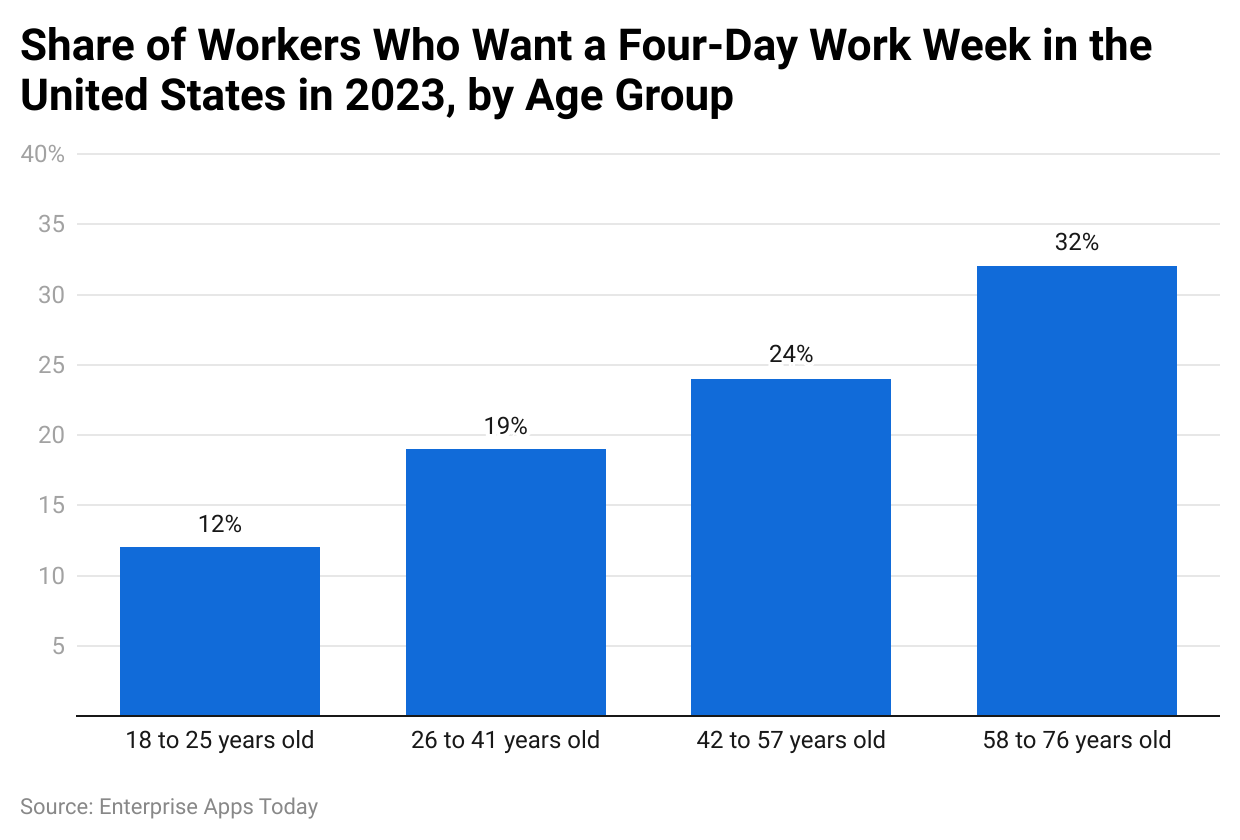 (Reference: statista.com)
(Reference: statista.com)
According to Four Day Work Week Statistics 2023, the majority of American employees want the same belonging to the 58 to 76 years age group contributing 32%. Surprisingly, there are only 12% of employees aged between 18 to 25 years want this kind of change in work structure. In addition to employees aged 26 to 41 years (19%) and 42 to 57 years (24%).
By Preferred Number Of Days To Work In The Office By CEOs
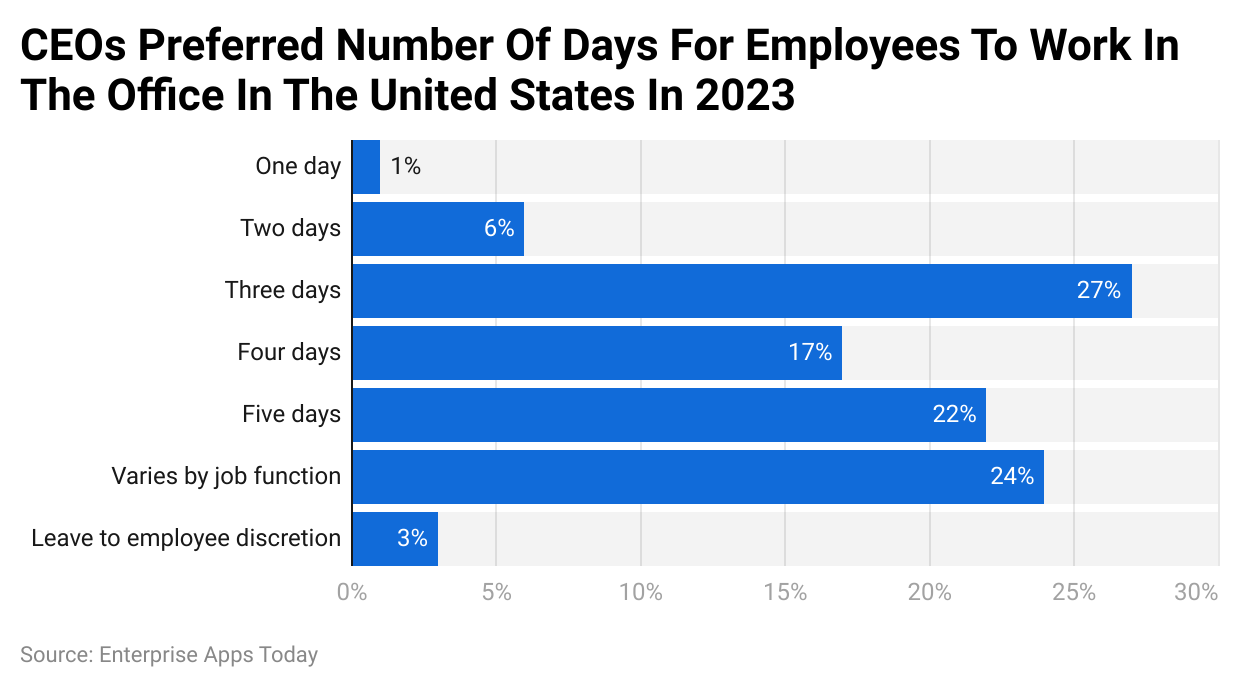 (Reference: statista.com)
(Reference: statista.com)
Considering the position of CEOs in the USA, only 17% of them are willing to work 4 days in the office. However, the majority want 3 days from office work contributing 27%. 3% of American CEOs said to leave this decision to employees. Other preferred work-from-office days include 1 day (1%), 2 days (6%), 3 days (27%), 5 days (22%), and changes according to job function (24%).
By Countries
Following the names of countries that are either taking trials or have permanently introduced this new working culture in government or non-governmental organizations.
| Country | Method (As of February 2024) | Working hours |
| Australia | Trial | |
| Dominican Republic | Trial | 36 hours |
| Brazil | Trial | 32 hours |
| Scotland | Trial | 32 hours |
| Portugal | Trial | 33 hours |
| South Africa | Trial | |
| Lithuania | Permanent (for parents with children aged below 3 years) | 32 hours |
| Belgium | Permanent | 38 hours |
| United Kingdom | Trial | |
| United Arab Emirates | Permanent |
36 hours (4.5 days)
|
| Ireland | Trial | |
| Spain | Trial | 32 hours |
| Japan | Recommended | |
| Iceland | Trial | 36 hours |
Countries such as India, the USA, Sri Lanka, Thailand, Wales, Canada, New Zealand, and Finland are likely to take trials in the coming months.
The Future Of Four-Day Workweeks
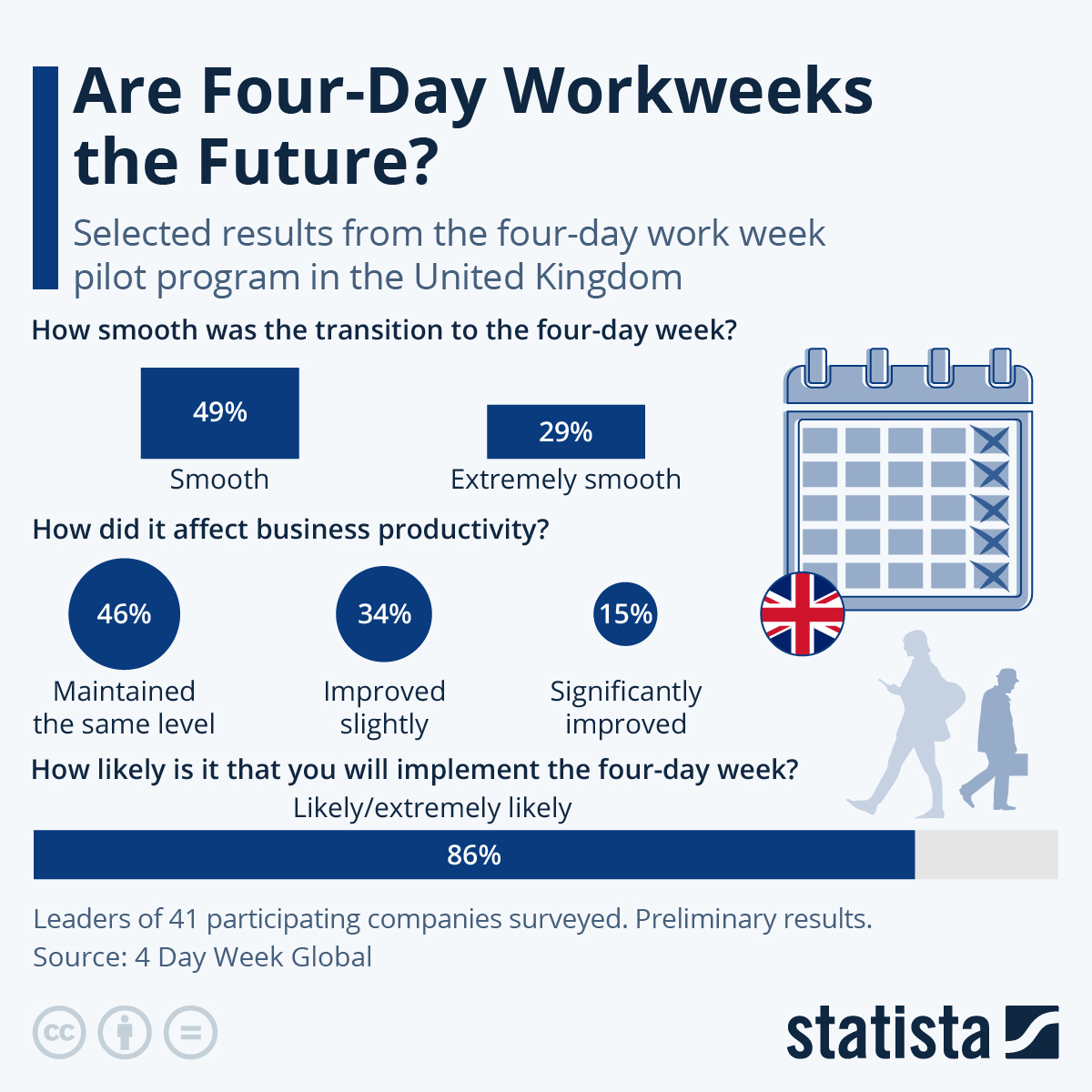
(Source: statista.com)
By Steps For Companies Needed To Taken To Foster Employees
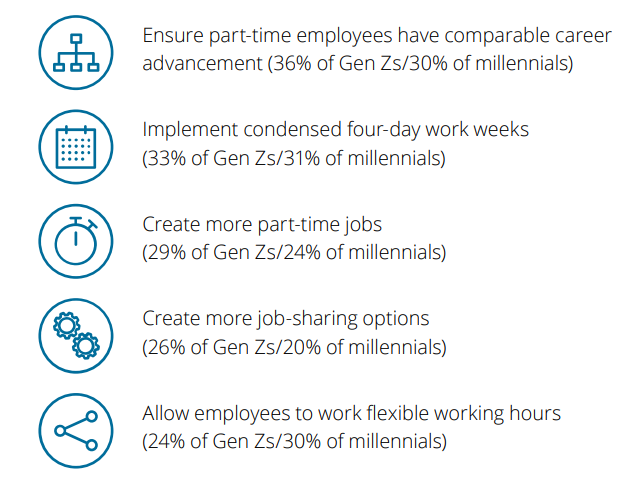
(Source: deloitte.com)
According to a report by Deloitte on Gen Z and Millennials, to foster employees in these generations, implementing a four-day work week is the second most required action voted by 33% – Gen Z and 31% Millennials. However, part-time employees get a comparable career is the top choice. Other requirements include creating more part-time jobs, creating more job-sharing options, and allowing employees to work flexible working hours.
By Demands
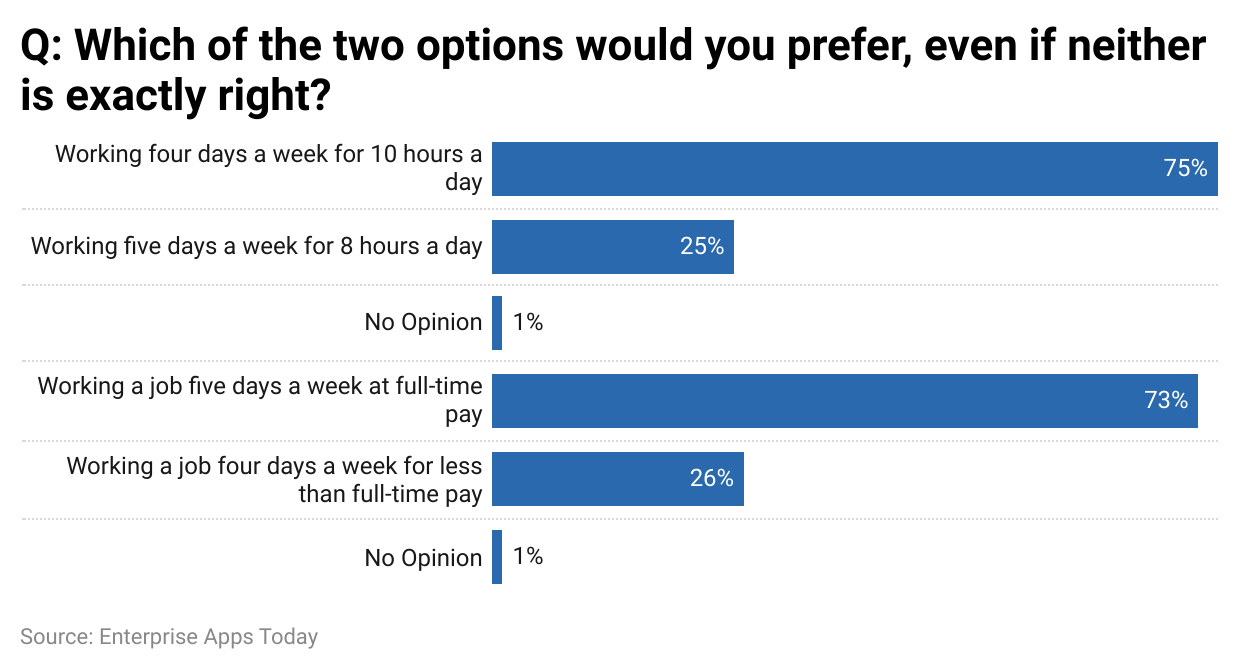 (Reference: washingtonpost.com)
(Reference: washingtonpost.com)
As of 2023, in the USA majority of the employees aged between 18 to 64 years responded to a survey by the Washington Post stating they prefer working four days a week and are ready to work 10 hours a day. Furthermore, the majority of the respondents prefer longer weekends with no pay cut.
By Typical Work Week Of Employees By Choice
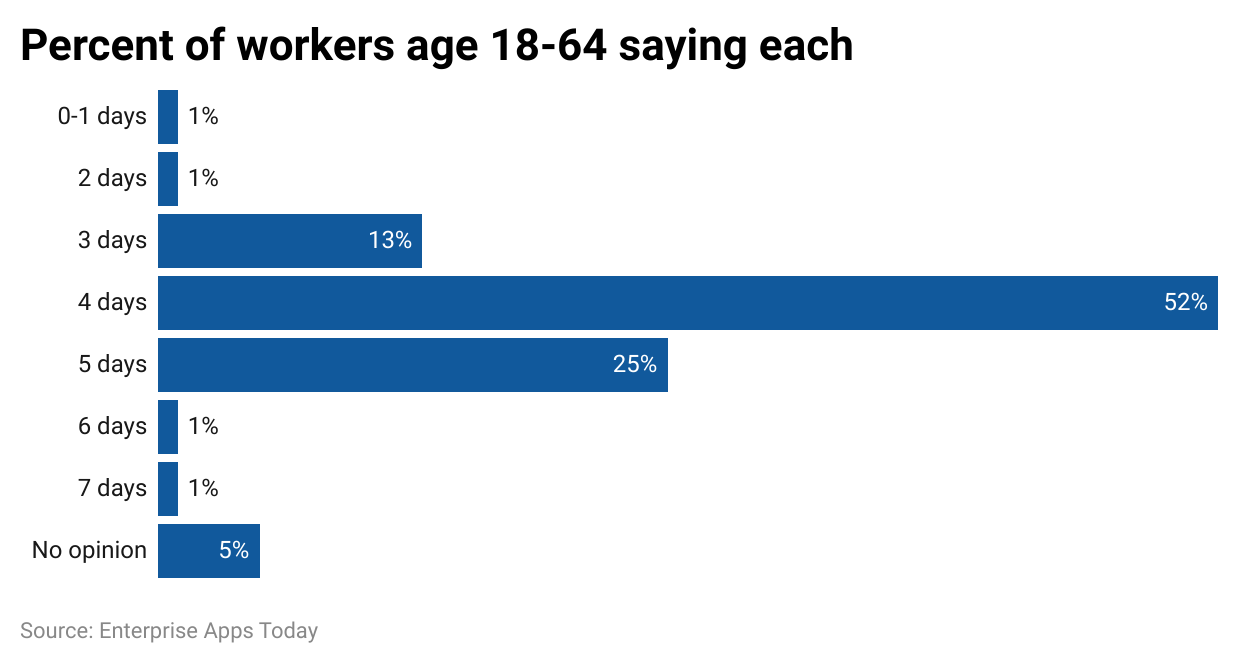 (Reference: washingtonpost.com)
(Reference: washingtonpost.com)
In addition to the above survey by the Washington Post, the majority of the employees prefer a 4-day workweek while 25% still prefer 5 workdays. On the other hand, 5% voted for no opinion at all.
Recent Developments
- Global Interest and Expansion: The concept of a 4DWW continues to gain traction globally, with companies like Shopify, Kickstarter, Basecamp, Amazon, and Microsoft exploring or implementing shorter work weeks.
- Legislative Actions in the U.S.: Several U.S. states are considering or have proposed legislation related to the 4DWW. These include California, Massachusetts, Missouri, Pennsylvania, Texas, and Vermont. The proposed legislation varies by state, with some focusing on the public sector, such as schools, and others aiming for broader implementation across industries.
- California has seen legislation proposed to reduce the standard workweek to 32 hours, requiring overtime compensation for hours worked beyond this threshold.
- Massachusetts introduced a bill for a two-year 4DWW pilot program offering tax credits to participating companies.
- Missouri has initiated a 4DWW for a significant number of its schools, aiming to improve teacher retention by reducing the workweek.
- Challenges and Opposition: Despite the enthusiasm, some states like Hawaii, Maryland, Utah, and Washington have faced challenges in implementing 4DWW proposals, with concerns ranging from the costs associated with reducing work hours to ensuring the effectiveness of such measures.
- Benefits and Workplace Transformation: The 4DWW is being hailed not just for potential wellbeing and productivity gains but also for its role in promoting workplace inclusivity and diversity. By allowing more flexible schedules, it's believed that the 4DWW can enable more parents and carers to engage in full-time employment, contributing positively to business strategy and creating a more diverse workforce.
Conclusion
Concluding these Four Day Work Week statistics, it is clear that in the future, the work culture around the world is going to change. It will allow employees the benefit of remote work, a 4-day workweek schedule, work-life balance, better mental and physical health, and good income options. As of 2024, many countries have started implementing this culture into companies while others are on trial. Since COVID-19 many things have changed in a good way, and have become in the favour of employees. It is not long before people will start working only 4 days a week and enjoy a long 3-day weekend.
- Adoption and Predictions: It is projected that by 2025, 80% of businesses will have adopted more flexible work schedules, including shorter work weeks. This trend is supported by 54% of HR professionals reporting an increase in employee inquiries about the possibility of a 4DWW. Furthermore, 64% of business leaders anticipate the 4DWW becoming the norm within the next decade, showcasing a substantial shift in workplace dynamics.
- Productivity and Employee Wellbeing: Studies have consistently shown that a 4DWW can lead to improved productivity and employee wellbeing. Notably, 77% of workers reported increased productivity under a 4DWW, with companies like Microsoft Japan witnessing a 40% boost in productivity during their experiment. Additionally, 78% of employees believe a shorter workweek would significantly improve their work-life balance.
- Employee Preferences and Benefits: The 4DWW is highly favored among employees, with 100% of respondents in a survey by Buffer expressing a preference to continue the 4DWW for the rest of their careers. This model has also been associated with lower stress levels, with 99.1% of employees feeling less stressed. Moreover, 61.5% of employees find it easier to manage work-life balance under a 4DWW, underscoring its potential to enhance overall life satisfaction.
- Challenges and Considerations: Despite the overwhelming support for the 4DWW, there are notable challenges. For instance, 62% of businesses believe implementing a 4DWW would necessitate a reduction in employee salaries. Additionally, 40% of employees are concerned about managing their workload within the reduced hours. These challenges highlight the need for strategic planning and adjustments to fully realize the benefits of a 4DWW without compromising operational efficiency.
In conclusion, the statistics and developments related to the 4DWW suggest a positive trajectory towards more flexible, efficient, and employee-friendly work environments. The potential benefits of improved productivity, employee wellbeing, and work-life balance are significant. However, the successful implementation of a 4DWW requires careful consideration of potential challenges, particularly in terms of workload management and compensation structures. As more companies experiment with and adopt this model, it will be crucial to monitor ongoing developments and adjust strategies accordingly to ensure that both businesses and employees can thrive in this evolving work landscape.
Sources
FAQ.
As the name suggests, in 4 4-day workweek culture, employees can work only 4 days in a week and have 3 days of long weekends. In this case, instead of 9 hours, 12 hours work shift is required to be completed within 4 days. The most suggested work days in this culture are Monday to Thursday. Majority of the americans have voted on 5 five-day work week culture as outdated, and many companies are taking
trails as of today.
4 day work week is beneficial because trials conducted by the companies suggested that it can improve the productivity of employees, reduce mental stress, improve work-life balance, reduce company charges related to electricity, and enhance revenue.
In 4 day work week, employees will work for more than 8 hours to complete the typical 32 to 36 working hours structure in just 4 days. This is proposed for Monday to Thursday and employees will have 3 days long weekend from Friday to Sunday.
Kickstarter, Monograph, Panasonic, thredUp, Elephant Ventures, Bit.io, Awin, DNSFilter, GooseChase, Justno, the Wanderlust Group, Primary.com, Bolt, Panasonic North America, Emtrain, The Financial Diet, Fifth Tribe, GoLinks, G2i, MNML, Knowledge Futures Group, Praytell and Nectafy are some of the companies offering 4 day work week culture.

Barry is a lover of everything technology. Figuring out how the software works and creating content to shed more light on the value it offers users is his favorite pastime. When not evaluating apps or programs, he's busy trying out new healthy recipes, doing yoga, meditating, or taking nature walks with his little one.